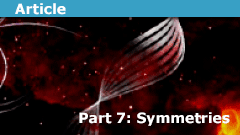Learn Symmetries in Mathematical Quantum Field Theory
The following is one chapter in a series on Mathematical Quantum Field Theory.
The previous chapter is 5. Lagrangians.
The next chapter is 7. Observables.
6. Symmetries
We have introduced the concept of Lagrangian field theories ##(E,\mathbf{L})## in terms of a field bundle ##E## equipped with a Lagrangian density ##\mathbf{L}## on its jet bundle (def. 5.1). Generally, given any object equipped with some structure, it is of paramount interest to determine the symmetries, hence the isomorphisms/equivalences of the object that preserve the given structure (this is the “Erlanger program”, Klein 1872).
The infinitesimal symmetries of the Lagrangian density (def. 6.6 below) send one field history to an infinitesimally nearby one which is “equivalent” for all purposes of field theory. Among these are the infinitesimal gauge symmetries which will be of concern below. A central theorem of variational calculus says that infinitesimal symmetries of the Lagrangian correspond to conserved currents, this is Noether’s theorem I, prop. 6.7 below. These conserved currents constitute an extension of the Lie algebra of symmetries, called the Dickey bracket.
But in (53) we have seen that the Lagrangian density of a Lagrangian field theory is just one component, in codimension 0, of an inhomogeneous “Lepage form” which in codimension 1 is given by the presymplectic potential current ##\Theta_{BFV}## (49). (This will be conceptually elucidated, after we have introduced the local BV-complex, in example 8.11 below.) This means that in codimension 1 we are to consider infinitesimal on-shell symmetries of the Lepage form ##\mathbf{L} + \Theta_{BFV}##. These are known as Hamiltonian vector fields (def. 6.19 below) and the analog of Noether’s theorem I now says that these correspond to Hamiltonian differential forms. The Lie algebra of these infinitesimal symmetries is called the local Poisson bracket (prop. 6.21 below).
Noether theorem and Hamiltonian Noether theorem
| variational form | symmetry | homotopy formula | physical quantity ##\,\,\,## | local symmetry algebra |
| Lagrangian density ##\mathbf{L}## (def. 5.1) | ##\mathcal{L}_v \mathbf{L} = d \tilde J## | ## d(\underset{= J_v}{\underbrace{\tilde J – \iota_v \Theta_{BFV}}}) = \iota_v \, \delta_{EL}\mathbf{L}## | conserved current ##J_v## (def. 6.6) | Dickey bracket |
| presymplectic current ##\Omega_{BFV}## (prop. 5.9) | ##\mathcal{L}^{var}_v \Theta_{BFV} = \delta \tilde H## | ##\delta(\underset{= H_v}{\underbrace{\tilde H_v – \iota_v \Theta_{BFV}}}) = \iota_v \Omega_{BFV}## | Hamiltonian form ##H_v## (def. 6.19) | local Poisson bracket (prop. 6.21) |
In the chapter Phase space below we transgress this local Poisson bracket of infinitesimal symmetries of the presymplectic potential current to the “global” Poisson bracket on the covariant phase space (def. 8.14 below). This is the structure which then further below leads over to the quantization (deformation quantization) of the prequantum field theory to a genuine perturbative quantum field theory. However, it will turn out that there may be an obstruction to this construction, namely the existence of special infinitesimal symmetries of the Lagrangian densities, called implicit gauge symmetries (discussed further below).
We now discuss these topics:
- Infinitesimal symmetries of the Lagrangian density
- Infinitesimal symmetries of the presymplectic potential current
infinitesimal symmetries of the Lagrangian density
Definition 6.1. (variation)
Let ##E \overset{fb}{\to} \Sigma## be a field bundle (def. 3.1).
A variation is a vertical vector field ##v## on the jet bundle ##J^\infty_\Sigma(E)## (def. 4.1) hence a vector field which vanishes when evaluated in the horizontal differential forms.
In the special case that the field bundle is trivial vector bundle over Minkowski spacetime as in example 3.4, a variation is of the form
$$
v = v^a \partial_{\phi^a} + v^a_{,\mu} \partial_{\phi^a_{,\mu}} + v^a_{\mu_1 \mu_2} \partial_{\phi^a_{\mu_1 \mu_2}} + \cdots
$$
The concept of variation in def. 6.1 is very general, in that it allows to vary the field coordinates independently from the corresponding jets. This generality is necessary for discussion of symmetries of presymplectic currents in def. 6.19 below. But for discussion of symmetries of Lagrangian densities we are interested in explicitly varying just the field coordinates (def. 6.2 below) and inducing from this the corresponding variations of the field derivatives (prop. 6.3) below.
In order to motivate the following definition 6.2 of evolutionary vector fields we follow remark 4.10 saying that concepts in variational calculus are obtained from their analogous concepts in plain differential calculus by replacing plain bundle morphisms by morphisms out of the jet bundle:
Given a fiber bundle ##E \overset{fb}{\to} \Sigma##, then a vertical vector field on ##E## is a section of its vertical tangent bundle ##T_\Sigma E## (def. 1.13), hence is a bundle morphism of this form
$$
\array{
E && \overset{\text{vertical vector field}}{\longrightarrow} && T_\Sigma E
\\
& {}_{\llap{id}}\searrow && \swarrow
\\
&& E
}
$$
The variational version replaces the vector bundle on the left with its jet bundle:
Definition 6.2. (evolutionary vector fields)
Let ##E \overset{fb}{\to} \Sigma## be a field bundle (def. 3.1). Then an evolutionary vector field ##v## on ##E## is “variational vertical vector field” on ##E##, hence a smooth bundle homomorphism out of the jet bundle (def. 4.1)
$$
\array{
J^\infty_\Sigma E
&& \overset{v}{\longrightarrow} &&
T_\Sigma E
\\
& {}_{\llap{jb_{\infty,0}}}\searrow && \swarrow_{\llap{}}
\\
&& E
}
$$
to the vertical tangent bundle ##T_\Sigma E \overset{}{\to} \Sigma## (def. 1.13) of ##E \overset{fb}{\to} \Sigma##.
In the special case that the field bundle is a trivial vector bundle over Minkowski spacetime as in example 3.4, this means that an evolutionary vector field is a tangent vector field (example 1.12) on ##J^\infty_\Sigma(E)## of the special form
$$
\begin{aligned}
v
& =
v^a \partial_{\phi^a}
\\
& =
v^a\left(
(x^\mu), (\phi^a), (\phi^a_{,\mu}), \cdots
\right) \partial_{\phi^a}
\end{aligned}
\,,
$$
where the coefficients ##v^a \in C^\infty(J^\infty_\Sigma(E))## are general smooth functions on the jet bundle (while the cmponents are tangent vectors along the field coordinates ##(\phi^a)##, but not along the spacetime coordinates ##(x^\mu)## and not along the jet coordinates ##\phi^a_{,\mu_1 \cdots \mu_k}##).
We write
$$
\Gamma_E^{ev}\left( T_\Sigma E \right)
\;\in\;
\Omega^{0,0}_\Sigma(E) Mod
$$
for the space of evolutionary vector fields, regarded as a module over the ##\mathbb{R}##-algebra
$$
\Omega^{0,0}_\Sigma(E)
\;=\;
C^\infty\left( J^\infty_\Sigma(E) \right)
$$
of smooth functions on the jet bundle.
An evolutionary vector field (def. 6.2) describes an infinitesimal change of field values depending on, possibly, the point in spacetime and the values of the field and all its derivatives (locally to finite order, by prop. 4.6).
This induces a corresponding infinitesimal change of the derivatives of the fields, called the prolongation of the evolutionary vector field:
Proposition 6.3. (prolongation of evolutionary vector field)
Let ##E \overset{fb}{\to} \Sigma## be a fiber bundle.
Given an evolutionary vector field ##v## on ##E## (def. 6.2) there is a unique tangent vector field ##\hat v## (example 1.12) on the jet bundle ##J^\infty_\Sigma(E)## (def. 4.1) such that
- ##\hat v## agrees on field coordinates (as opposed to jet coordinates) with ##v##:$$
(jb_{\infty,0})_\ast(\hat v) = v
\,,
$$which means in the special case that ##E \overset{fb}{\to} \Sigma## is a trivial vector bundle over Minkowski spacetime (example 3.4) that ##\hat v## is of the form$$
\label{GenericComponentsForProlongationOfEvolutionaryVectorField}
\hat v
\;=\;
\underset{
= v
}{
\underbrace{
v^a \partial_{\phi^a}
}}
\,+\,
\hat v^a_{\mu} \partial_{\phi^a_{,\mu}}
+
\hat v^a_{\mu_1 \mu_2} \partial_{\phi^a_{,\mu_1 \mu_2}}
+
\cdots
$$(67) - contraction with ##\hat v## (def. 1.20) anti-commutes with the total spacetime derivative (def. 4.11):
$$
\label{ProlongedEvolutionaryVectorFieldContractionAnticommutedWithHorizontalDerivative}
\iota_{\hat v} \circ d + d \circ \iota_{\hat v} = 0
\,.
$$(68)
In particular Cartan’s homotopy formula (prop. 1.22) for the Lie derivative ##\mathcal{L}_{\hat v}## holds with respect to the variational derivative ##\delta##:
| $$ \label{HomotopyFormulaForLieDerivativeAlongProlongationOfEvolutionaryVectorField} \mathcal{L}_{\hat v} = \delta \circ \iota_{\hat v} + \iota_{\hat v} \circ \delta $$ | (69) |
Explicitly, in the special case that the field bundle is a trivial vector bundle over Minkowski spacetime (example 3.4) ##\hat v## is given by
| $$ \label{ProlongationOfEvolutionaryVectorFieldExplicit} \hat v = \underset{n = 0}{\overset{\infty}{\sum}} \frac{d^n v^a}{ d x^{\mu_1} \cdots d x^{\mu_n} } \partial_{\phi^a_{\mu_1 \cdots \mu_n}} \,. $$ | (70) |
Proof. It is sufficient to prove the coordinate version of the statement. We prove this by induction over the maximal jet order ##k##. Notice that the coefficient of ##\partial_{\phi^a_{\mu_1 \cdots \mu_k}}## in ##\hat v## is given by the contraction ##\iota_{\hat v} \delta \phi^a_{\mu_1 \cdots \mu_k}## (def. 1.20).
Similarly (at “##k = -1##”) the component of ##\partial_{\mu_1}## is given by ##\iota_{\hat v} d x^{\mu}##. But by the second condition above this vanishes:
$$
\begin{aligned}
\iota_{\hat v} d x^\mu
& =
d \iota_{\hat v} x^\mu
\\
& =
0
\end{aligned}
$$
Moreover, the coefficient of ##\partial_{\phi^a}## in ##\hat v## is fixed by the first condition above to be
$$
\iota_{\hat v} \delta \phi^a
=
v^a
\,.
$$
This shows the statement for ##k = 0##. Now assume that the statement is true up to some ##k \in \mathbb{N}##. Observe that the coefficients of all ##\partial_{\phi^a_{\mu_1 \cdots \mu_{k+1}}}## are fixed by the contractions with ##\delta \phi^a_{\mu_1 \cdots \mu_{k} \mu_{k+1}} \wedge d x^{\mu_{k+1}}##. For this we find again from the second condition and using ##\delta \circ d + d \circ \delta = 0## as well as the induction assumption that
$$
\begin{aligned}
\iota_{\hat v} \delta \phi^a_{\mu_1 \cdots \mu_{k+1}} \wedge d x^{\mu_{k+1}}
& =
\iota_{\hat v} \delta d \phi^a_{\mu_1 \cdots \mu_k}
\\
& =
d \iota_{\hat v} \delta \phi^a_{\mu_1 \cdots \mu_k}
\\
&
= d \frac{d^k v^a}{d x^{\mu_1} \cdots d x^{\mu_k}}
\\
& =
\frac{d^{k+1}v^a }{d x^{\mu_1} \cdots d x^{\mu_{k+1}}} d x^{\mu_{k+1}}
\,.
\end{aligned}
$$
This shows that ##\hat v## satisfying the two conditions given exists uniquely.
Finally formula (69) for the Lie derivative follows from the second of the two conditions with Cartan’s homotopy formula ##\mathcal{L}_{\hat v} = \mathbf{d} \circ \iota_{\hat v} + \iota_{\hat v} \circ \mathbf{d}## (prop. 1.22) together with ##\mathbf{d} = \delta + d## (33).
Proposition 6.4. (evolutionary vector fields form a Lie algebra)
Let ##E \overset{fb}{\to} \Sigma## be a fiber bundle. For any two evolutionary vector fields ##v_1##, ##v_2## on ##E## (def. 6.2) the Lie bracket of tangent vector fields of their prolongations ##\hat v_1##, ##\hat v_2## (def. 6.3) is itself the prolongation ##\widehat{[v_1, v_2]}## of a unique evolutionary vector field ##[v_1,v_2]##.
This defines the structure of a Lie algebra on evolutionary vector fields.
Proof. It is clear that ##[\hat v_1, \hat v_2]## is still vertical, therefore, by prop. 6.3, it is sufficient to show that contraction ##\iota_{[v_1, v_2]}## with this vector field (def. 1.20) anti-commutes with the horizontal derivative ##d##, hence that ##[d, \iota_{[\hat v_1, \hat v_2]}] = 0##.
Now ##[d, \iota_{[\hat v_1, \hat v_2]}]## is an operator that sends vertical 1-forms to horizontal 1-forms and vanishes on horizontal 1-forms. Therefore it is sufficient to see that this operator in fact also vanishes on all vertical 1-forms. But for this it is sufficient that it commutes with the vertical derivative. This we check by Cartan calculus, using ##[d,\delta] = 0## and ##[d, \iota_{\hat v_i}]##, by assumption:
$$
\begin{aligned}
{[ \delta, [ d,\iota_{[\hat v_1, \hat v_2]}] ]}
& =
– [d, [\delta, \iota_{[\hat v_1, \hat v_2]}]]
\\
& =
– [d, \mathcal{L}_{[\hat v_1, \hat v_2]}]
\\
& =
-[d, [\mathcal{L}_{\hat v_1}, \iota_{\hat v_2}] ]
\\
& =
– [d, [ [\delta, \iota_{\hat v_1}], \iota_{\hat v_2} ]]
\\
& =
0
\,.
\end{aligned}
$$
Now given an evolutionary vector field, we want to consider the flow that it induces on the space of field histories:
Definition 6.5. (flow of field histories along evolutionary vector field)
Let ##E \overset{fb}{\to} \Sigma## be a field bundle (def. 3.1) and let ##v## be an evolutionary vector field (def. 6.2) such that the ordinary flow of its prolongation ##\hat v## (prop. 6.3)
$$
\exp(t \hat v)
\;\colon\; J^\infty_\Sigma(E) \longrightarrow J^\infty_\Sigma(E)
$$
exists on the jet bundle (e.g. if the order of derivatives of field coordinates that it depends on is bounded).
For ##\Phi_{(-)} \colon U_1 \to \Gamma_\Sigma(E)## a collection of field histories (hence a plot of the space of field histories (def. 3.46) ) the flow of ##v## through ##\Phi_{(-)}## is the smooth function
$$
U_1 \times \mathbb{R}^1
\overset{\exp(v)(\Phi_{(-)})}{\longrightarrow}
\Gamma_\Sigma(E)
$$
whose unique factorization ##\widehat{\exp(v)}(\Phi_{(-)})## through the space of jets of field histories (i.e. the image ##im(j^\infty_\Sigma)## of jet prolongation, def. 4.2)
$$
\array{
&& im(j^\infty_\Sigma) &\hookrightarrow& \Gamma_\Sigma(J^\infty_\Sigma(E))
\\
& {}^{\llap{\widehat{\exp(v)}(\Phi_{(-)})}} \nearrow& \downarrow^{\rlap{\simeq}}
\\
U_1 \times \mathbb{R}^1
&\underset{ \exp(v)(\Phi) }{\longrightarrow}&
\Gamma_{\Sigma}(E)_{}
}
$$
takes a plot ##t_{(-)} \;\colon\; U_2 \to \mathbb{R}^1## of the real line (regarded as a super smooth set via example 3.41), to the plot
| $$ \label{LocalDataForFlowOfImplicitInfinitesimalGaugeSymmetry} (\exp(t(-) \hat v) \circ j^\infty_\Sigma(\Phi_{(-)}) \;\colon\: U_1 \times U_2 \longrightarrow \Gamma_\Sigma\left( J^\infty_\Sigma(E) \right) $$ | (71) |
of the smooth space of sections of the jet bundle.
(That ##\exp(t(-) \hat v)## indeed flows jet prolongations ##j^\infty_\Sigma(\Phi(-))## again to jet prolongations is due to its defining relation to the evolutionary vector field ##v## from prop. 6.3.)
Definition 6.6. (infinitesimal symmetries of the Lagrangian and conserved currents)
Let ##(E,\mathbf{L})## be a Lagrangian field theory (def. 5.1).
Then
- an infinitesimal symmetry of the Lagrangian is an evolutionary vector field ##v## (def. 6.2) such that the Lie derivative ##\mathcal{L}_{\hat v} \mathbf{L}## of the Lagrangian density along its prolongation ##\hat v## (prop. 6.3) is a total spacetime derivative:$$
\mathcal{L}_{\hat v} \mathbf{L} \;=\; d \tilde J_{\hat v}
$$ - an on-shell conserved current is a horizontal ##p##-form ##J \in \Omega^{p,0}_\Sigma(E)## (def. 4.11) whose total spacetime derivative vanishes on the prolonged shell (47)$$
d J\vert_{\mathcal{E}^\infty} \;=\; 0
\,.
$$
Proposition 6.7. (Noether’s theorem I)
Let ##(E,\mathbf{L})## be a Lagrangian field theory (def. 5.1).
If ##v## is an infinitesimal symmetry of the Lagrangian (def. 6.6) with ##\mathcal{L}_{\hat v} \mathbf{L} = d \tilde J_{\hat v}##, then
| $$ \label{NoetherCurrent} J_{\hat v} := \tilde J_{\hat v} – \iota_{\hat v} \Theta_{BFV} $$ | (72) |
is an on-shell conserved current (def. 6.6), for ##\Theta_{BFV}## a presymplectic potential (49) from def. 5.9.
Proof. By Cartan’s homotopy formula for the Lie derivative (prop. 1.22) and the decomposition of the variational derivative ##\delta \mathbf{L}## (45) and the fact that contraction ##\iota_{\hat v}## with the prolongtion of an evolutionary vector field vanishes on horizontal differential forms (67) and anti-commutes with the horizontal differential (68), by def. 6.2, we may re-express the defining equation for the symmetry as follows:
$$
\begin{aligned}
d \tilde J_{\hat v}
& =
\mathcal{L}_{\hat v} \mathbf{L}
\\
& =
\iota_{\hat v} \underset{= \delta_{EL}\mathbf{L} – d \Theta_{BFV}}{\underbrace{\mathbf{d} \mathbf{L}}}
+
\mathbf{d} \underset{= 0}{\underbrace{\iota_v \mathbf{L}}}
\\
& =
\iota_{\hat v} \delta_{EL} \mathbf{L}
+ d \iota_{\hat v} \Theta_{BFV}
\end{aligned}
$$
which is equivalent to
$$
d(\underset{= J_{\hat v}}{\underbrace{\tilde J_{\hat v} – \iota_{\hat v} \Theta_{BFV}}}) = \iota_{\hat v} \delta_{EL}\mathbf{L}
$$
Since, by definition of the shell ##\mathcal{E}##, the differential form on the right vanishes on ##\mathcal{E}## this yields the claim.
Example 6.8. (energy-momentum of the scalar field)
Consider the Lagrangian field theory of the free scalar field from def. 5.4:
$$
\mathbf{L}
\;=\;
\tfrac{1}{2}
\left(
\eta^{\mu \nu}\phi_{,\mu} \phi_{,\nu}
–
m^2 \phi^2
\right)
dvol_\Sigma
\,.
$$
For ##\nu \in \{0, 1, \cdots, p\}## consider the vector field on the jet bundle given by
$$
v_\nu
\;:=\;
\phi_{,\nu} \partial_{\phi}
+
\phi_{,\mu \nu} \partial_{\phi_{,\mu}}
+
\cdots
\,.
$$
This describes infinitesimal translations of the fields in the direction of ##\partial_\nu##.
And this is an infinitesimal symmetry of the Lagrangian (def. 6.6), since
$$
\iota_{v_\nu} \mathbf{d}\mathbf{L}
=
d L \wedge \iota_{\partial_\nu} dvol_\Sigma
\,.
$$
With the formula (59) for the presymplectic potential
$$
\Theta_{BFV}
=
\eta^{\mu \nu} \phi_{,\mu} \delta \phi \iota_{\partial_{\nu}} dvol_\Sigma
$$
it hence follows from Noether’s theorem (prop. 6.7) that the corresponding conserved current (def. 6.6) is
$$
\begin{aligned}
T_\nu
& =
L \, \iota_{\partial_\nu} dvol_\Sigma
–
\iota_{v_\nu}\Theta_{BFV}
\\
&
=
L \, \iota_{\partial_\nu} dvol_\Sigma
–
\eta^{\rho \mu} \phi_{,\rho} \phi_{,\nu}
\,
\iota_{\partial_\mu} dvol_\Sigma
\\
& =
(
\underset{=: T^\mu_\nu}{
\underbrace{
\delta^\mu_\nu L
–
\eta^{\rho \mu} \phi_{,\rho} \phi_{,\nu}
}
}
)
\,
\iota_{\partial_\mu} dvol_\Sigma
\end{aligned}
\,.
$$
This conserved current is called the energy-momentum tensor.
Example 6.9. (Dirac current)
Consider the Lagrangian field theory of the free Dirac field on Minkowski spacetime in spacetime dimension ##p + 1 = 3+1## (example 5.9)
$$
\mathbf{L} = i \overline{\psi} \gamma^\mu \psi_{,\mu} \, dvol_\Sigma
\,.
$$
Then the prolongation (prop. 6.3) of the evolutionary vector field (def. 6.2)
$$
v \;:=\; i \psi_\alpha \partial_{\psi_\alpha}
$$
is an infinitesimal symmetry of the Lagrangian (def. 6.6). The conserved current that corresponds to this under Noether’s theorem I (prop. 6.7) is
$$
–
i
\overline{\psi} \gamma^\mu \psi \, \iota_{\partial_\mu} dvol_\Sigma
\;\in\;
\Omega^{p,0}_{\Sigma}(E)
\,.
$$
This is called the Dirac current.
In fact, due to the supergeometric nature of the Dirac field, the Dirac current is conserved even off-shell, as discussed in remark 5.23.
Proof. By equation (75) the prolongation of ##v## is
$$
\hat v
=
i \psi_\alpha \partial_{\psi_\alpha}
+
i \psi_{\alpha,\mu} \partial_{\psi_{\alpha,\mu}}
+
\cdots
\,.
$$
Therefore the Lagrangian density is strictly invariant under the Lie derivative along ##\hat v##
$$
\begin{aligned}
\mathcal{L}_{\hat v} \left(
i \overline{\psi} \gamma^\mu \psi_{,\mu}
\right)
dvol_\Sigma
& =
\underset{
= i \cdot (-i) \overline{\psi} \gamma^\mu \psi_{,\mu}
}{
\underbrace{
i \overline{i \psi} \gamma^\mu \psi_{,\mu}
}
}
dvol_\Sigma
+
\underset{
i \cdot i \overline{\psi} \gamma^\mu \psi_{,\mu}
}{
\underbrace{
i \overline{\psi} \gamma^\mu (i \psi_{,\mu})
}
}
dvol_\Sigma
\\ & =
0
\,.
\end{aligned}
$$
and so the formula for the corresponding conserved current (77) is
$$
\begin{aligned}
J_v
& =
– \iota_{\hat v}
\left(
\underset{
\overline{\psi}
\gamma^\mu
\delta \psi
\,
\iota_{\partial_\mu} dvol_\Sigma }{
\underbrace{
\Theta_{BFV}
}
}
\right)
\\
&
= – i \overline{\psi}\gamma^\mu \psi \, \iota_{\partial_\mu} dvol_\Sigma
\end{aligned}
\,,
$$
where under the brace we used example 5.21 to identify the presymplectic potential for the free Dirac field.
Since an infinitesimal symmetry of a Lagrangian (def. 6.6) by definition changes the Lagrangian only up to a total spacetime derivative, and since the Euler-Lagrange equations of motion by construction depend on the Lagrangian density only up to a total spacetime derivative (prop. 5.9), it is plausible that and infinitesimal symmetry of the Lagrangian preserves the equations of motion (46), hence the shell (48). That this is indeed the case is the statement of prop. 6.16 below.
To make the proof transparent, we now first introduce the concept of the evolutionary derivative (def. 6.12) below and then observe that in terms of these the Euler-Lagrange derivative is in fact a derivation (prop. 6.14).
Definition 6.10. (field-dependent sections)
For
$$
E \overset{fb}{\longrightarrow} \Sigma
$$
a fiber bundle (def. 1.9), regarded as a field bundle (def. 3.1), and for
$$
E’ \overset{fb’}{\longrightarrow} \Sigma
$$
any other fiber bundle over the same base space (spacetime), we write
$$
\Gamma_{J^\infty_\Sigma(E)}(E’)
\;:=\;
\Gamma_{J^\infty_\Sigma(E)}( jb^\ast E’ )
\;=\;
Hom_\Sigma(J^\infty_\Sigma(E), E’)
\;\simeq\;
DiffOp(E,E’)
$$
for the space of sections of the pullback of bundles of ##E’## to the jet bundle ##J^\infty_\Sigma(E) \overset{jb}{\longrightarrow} \Sigma## (def. 4.1) along ##jb##.
$$
\Gamma_{J^\infty_\Sigma(E)}(E’)
\;=\;
\left\{
\array{
&& E’
\\
& {}^{\llap{}}\nearrow & \downarrow \rlap{fb’}
\\
J^\infty_\Sigma(E)
&\underset{jb}{\longrightarrow}&
\Sigma
}
\phantom{A}\,\,
\right\}
\,.
$$
(Equivalently this is the space of differential operators from sections of ##E## to sections of ##E’##, according to prop. 4.7. )
In (Olver 93, section 5.1, p. 288) the field dependent sections of def. 6.10, considered in local coordinates, are referred to as tuples of differential functions.
Example 6.11. (source forms and evolutionary vector fields are field-dependent sections)
For ##E \overset{fb}{\to} \Sigma## a field bundle, write ##T_\Sigma E## for its vertical tangent bundle (example 1.13) and ##T_\Sigma^\ast E## for its dual vector bundle (def. 1.14), the vertical cotangent bundle.
Then the field-dependent sections of these bundles according to def. 6.10 are identified as follows:
- the space ##\Gamma_{J^\infty_\Sigma(E)}(T_\Sigma E)## contains the space of evolutionary vector fields ##v## (def. 6.2) as those bundle morphism which respect not just the projection to ##\Sigma## but also its factorization through ##E##:$$
\left(
\array{
&& T_\Sigma E
\\
& {}^{\llap{v}}\nearrow & \downarrow^{\rlap{tb_\Sigma}}
\\
J^\infty_\Sigma(E) &\underset{jb_{\infty,0}}{\longrightarrow}& E & \underset{fb}{\longrightarrow}& \Sigma
}
\right)
\;\in\;
\Gamma_{J^\infty_\Sigma(E)}(T_\Sigma E)
$$ - ##\Gamma_{J^\infty_\Sigma(E)}( T^\ast_\Sigma E) \otimes \wedge^{p+1}_\Sigma(T^\ast \Sigma)## contains the space of source forms ##E## (prop. 5.9) as those bundle morphisms which respect not just the projection to ##\Sigma## but also its factorization through ##E##:$$
\left(
\array{
&& T^\ast_\Sigma E
\\
& {}^{E}\nearrow & \downarrow^{\rlap{ctb_\Sigma}}
\\
J^\infty_\Sigma(E) &\underset{jb_{\infty,0}}{\longrightarrow}& E & \underset{fb}{\longrightarrow}& \Sigma
}
\right)
\;\in\;
\Gamma_{J^\infty_\Sigma(E)}(T^\ast_\Sigma E)
$$
This makes manifest the duality pairing between source forms and evolutionary vector fields
$$
\array{
\Gamma_{J^\infty_\Sigma(E)}(T_\Sigma E)
\otimes
\Gamma_{J^\infty_\Sigma(E)}(T^\ast_\Sigma E)
&\longrightarrow&
C^\infty(J^\infty_\Sigma(E))
}
$$
which in local coordinates is given by
$$
(v^a \partial_{\phi^a} \,,\, \omega_a \delta \phi^a)
\mapsto
v^a \omega_a
$$
for ##v^a, \omega_a \in C^\infty(J^\infty_\Sigma(E))## smooth functions on the jet bundle (as in prop. 4.6).
Definition 6.12. (evolutionary derivative of field-dependent section)
Let
$$
E \overset{fb}{\to} \Sigma
$$
be a fiber bundle regarded as a field bundle (def. 3.1) and let
$$
V \overset{vb}{\to} \Sigma
$$
be a vector bundle (def. 1.10). Then for
$$
P \in \Gamma_{J^\infty_\Sigma(E)}(V)
$$
a field-dependent section of ##E## according to def. 6.10, its evolutionary derivative is the morphism
$$
\array{
\Gamma_{J^\infty_\Sigma(E)}(T_\Sigma E)
& \overset{ \mathrm{D}P }{\longrightarrow} &
\Gamma_{J^\infty_\Sigma(E)}(V)
\\
v &\mapsto& \hat v(P)
}
$$
which, under the identification of example 6.11, sense an evolutionary vector field ##v## to the derivative of ##P## (example 1.12) along the prolongation tangent vector field ##\hat v ## of ##v## (prop. 6.3).
In the case that ##E## and ##V## are trivial vector bundles over Minkowski spacetime with coordinates ##((x^\mu), (\phi^a))## and ##((x^\mu), (\rho^b))##, respectively (example 3.4), then by (70) this is given by
$$
((\mathrm{D}P)(v))^b
\;=\;
\left(
v^a \frac{\partial P^b}{\partial \phi^a}
+
\frac{d v^a}{d x^\mu}
\frac{\partial P^b}{\partial \phi^a_{,\mu}}
+
\frac{d^2 v^a}{d x^\mu d x^\nu}
\frac{\partial P^b}{\partial \phi^a_{,\mu \nu}}
+
\cdots
\right)
$$
This makes manifest that ##\mathrm{D}P## may equivalently be regarded as a ##J^\infty_\Sigma(E)##-dependent differential operator (def. 4.7) from the vertical tangent bundle ##T_\Sigma E## (def. 1.13) to ##V##, namely a bundle homomorphism over ##\Sigma## of the form
$$
\mathrm{D}_P
\;\colon\;
J^\infty_\Sigma(E) \times_\Sigma J^\infty_\Sigma T_\Sigma E
\longrightarrow
V
$$
in that
| $$ \label{FrechetDerivativeAsDifferentialOperatorEquality} \mathrm{D}_P(-,v) = \mathrm{D}P(v) = \hat v (P) \,. $$ | (73) |
(Olver 93, def. 5.24)
Example 6.13. (evolutionary derivative of Lagrangian function)
Over Minkowski spacetime ##\Sigma## (def. 2.17), let ##\mathbf{L} = L dvol \in \Omega^{p,0}_\Sigma(E)## be a Lagrangian density (def. 5.1), with coefficient function regarded as a field-dependent section (def. 6.10) of the trivial real line bundle:
$$
L \;\in \; \Gamma_{J^\infty_\Sigma}(E)(\Sigma \times \mathbb{R})
\,,
$$
Then the formally adjoint differential operator (def. 4.9)
$$
(\mathrm{D}_L)^\ast
\;\colon\;
J^\infty_\Sigma(E)\times_\Sigma (\Sigma \times \mathbb{R})^\ast
\longrightarrow
T_\Sigma^\ast E
$$
of its evolutionary derivative, def. 6.12, regarded as a ##J^\infty_\Sigma(E)##-dependent differential operator ##\mathrm{D}_P## from ##T_\Sigma## to ##V## and applied to the constant section
$$
1 \in \Gamma_\Sigma(\Sigma \times \mathbb{R}^\ast)
$$
is the Euler-Lagrange derivative (46)
$$
\delta_{EL}\mathbf{L}
\;=\;
\left(\mathrm{D}_{L}\right)^\ast(1)
\;\in\;
\Gamma_{J^\infty_\Sigma(E)}(T_\Sigma^\ast)
\simeq
\Omega^{p+1,1}_\Sigma(E)_{source}
$$
via the identification from example 6.11.
Proposition 6.14. (Euler-Lagrange derivative is derivation via evolutionary derivatives)
Let ##V \overset{vb}{\to} \Sigma## be a vector bundle (def. 1.10) and write ##V^\ast \overset{}{\to} \Sigma## for its dual vector bundle (def. 1.14).
For field-dependent sections (def. 6.10)
$$
\alpha \in \Gamma_{J^\infty_\Sigma(E)}(V)
$$
and
$$
\beta^\ast \in \Gamma_{J^\infty_\Sigma(E)}(V^\ast)
$$
we have that the Euler-Lagrange derivative (46) of their canonical pairing to a smooth function on the jet bundle (as in prop. 4.6) is the sum of the derivative of either one via the formally adjoint differential operator (def. 4.9) of the evolutionary derivative (def. 6.12) of the other:
$$
\delta_{EL}( \alpha \cdot \beta^\ast )
\;=\;
(\mathrm{D}_\alpha)^\ast(\beta^\ast)
+
(\mathrm{D}_{\beta^\ast})^\ast(\alpha)
$$
Proof. It is sufficient to check this in local coordinates. By the product law for differentiation> we have
$$
\begin{aligned}
\frac{
\delta_{EL} \left(\alpha \cdot \beta^\ast \right)
}
{
\delta \phi^a
}
& =
\frac{\partial \left(\alpha \cdot \beta^\ast \right)}{\partial \phi^a}
–
\frac{d}{d x^\mu}
\left(
\frac{\partial \left( \alpha \cdot \beta^\ast \right)}{\partial \phi^a_{,\mu}}
\right)
+
\frac{d}{d x^\mu d x^\nu}
\left(
\frac{\partial \left( \alpha \cdot \beta^\ast \right) }{\partial \phi^a_{,\mu \nu}}
\right)
–
\cdots
\\
& =
\phantom{+}
\frac{\partial \alpha }{\partial \phi^a}
\cdot \beta^\ast
–
\frac{d}{d x^\mu}
\left(
\frac{\partial \alpha }{\partial \phi^a_{,\mu}}
\cdot
\beta^\ast
\right)
+
\frac{d}{d x^\mu d x^\nu}
\left(
\frac{\partial \alpha }{\partial \phi^a_{,\mu \nu}}
\cdot
\beta^\ast
\right)
–
\cdots
\\
& \phantom{=}
+
\frac{\partial \beta^\ast }{\partial \phi^a}
\cdot \alpha
–
\frac{d}{d x^\mu}
\left(
\frac{\partial \beta^\ast }{\partial \phi^a_{,\mu}}
\cdot
\alpha
\right)
+
\frac{d}{d x^\mu d x^\nu}
\left(
\frac{\partial \beta^\ast }{\partial \phi^a_{,\mu \nu}}
\cdot
\alpha
\right)
–
\cdots
\\
& =
(\mathrm{D}_\alpha)^\ast(\beta^\ast)
+
(\mathrm{D}_{\beta^\ast})^\ast(\alpha)
\end{aligned}
$$
Proposition 6.15. (evolutionary derivative of Euler-Lagrange forms is formally self-adjoint)
Let ##(E,\mathbf{L})## be a Lagrangian field theory (def. 5.1) over Minkowski spacetime (def. 2.17) and regard the Euler-Lagrange derivative
$$
\delta_{EL}\mathbf{L}
\;=\;
\delta_{EL}L \wedge dvol_\Sigma
$$
(from prop. 5.9) as a field-dependent section of the vertical cotangent bundle
$$
\delta_{EL}L
\;\in\;
\Gamma_{J^\infty_\Sigma(E)}(T^\ast_\Sigma E)
$$
as in example 6.11. Then the corresponding evolutionary derivative field-dependent differential operator ##D_{\delta_{EL}L}## (def. 6.12) is formally self-adjoint (def. 4.9):
$$
(D_{\delta_{EL}L})^\ast
\;=\;
D_{\delta_{EL}L}
$$
(Olver 93, theorem 5.92) The following proof is due to Igor Khavkine.
Proof. By definition of the Euler-Lagrange form (def. 5.9) we have
$$
\frac{\delta_{EL} L }{\delta \phi^a}
\delta \phi^a
\,
\wedge
dvol_\Sigma
\;=\;
\delta L \,\wedge dvol_\Sigma \;+\; d(…)
\,.
$$
Applying the variational derivative ##\delta## (def. 4.11) to both sides of this equation yields
$$
\left(\delta \frac{\delta_{EL} L }{\delta \phi^a}\right)
\wedge
\delta \phi^a
\,
\wedge
dvol_\Sigma
\;=\;
\underset{= 0}{\underbrace{\delta \delta L}} \wedge dvol_\Sigma
\;+\;
d(…)
\,.
$$
It follows that for ##v,w## any two evolutionary vector fields the contraction (def. 1.20) of their prolongations ##\hat v## and ##\hat w## (def. 6.3) into the differential 2-form on the left is
$$
\left(
\delta \frac{\delta_{EL} L }{\delta \phi^a}
\wedge
\delta \phi^a
\right)(v,w)
=
w^a
(\mathrm{D}_{\delta_{EL}})_a(v)
–
v^b(\mathrm{D}_{\delta_{EL}})_b(w)
\,,
$$
by inspection of the definition of the evolutionary derivative (def. 6.12). Moreover, their contraction into the differential form on the right is
$$
\iota_{\hat v}
\iota_{\hat w}
d(…)
\;=\;
d(…)
$$
by the fact (prop. 6.3) that contraction with prolongations of evolutionary vector fields antio-commutes with the total spacetime derivative (68).
Hence the last two equations combined give
$$
w^a
(\mathrm{D}_{\delta_{EL}})_a(v)
–
v^b(\mathrm{D}_{\delta_{EL}})_b(w)
\;=\;
d(…)
\,.
$$
This is the defining condition for ##\mathrm{D}_{\delta_{EL}}## to be formally self-adjoint differential operator (def. 4.9).
Now we may finally prove that an infinitesimal symmetry of the Lagrangian is also an infinitesimal symmetry of the Euler-Lagrange equations of motion:
Proposition 6.16. (infinitesimal symmetries of the Lagrangian are also infinitesimal symmetries of the equations of motion)
Let ##(E,\mathbf{L})## be a Lagrangian field theory. If an evolutionary vector field ##v## is an infinitesimal symmetry of the Lagrangian then the flow along its prolongation ##\hat v## preserves the prolonged shell ##\mathcal{E}^\infty \hookrightarrow J^\infty_\Sigma(E)## (48) in that the Lie derivative of the Euler-Lagrange form ##\delta_{EL}\mathbf{L}## along ##\hat v## vanishes on ##\mathcal{E}^\infty##:
$$
\mathcal{L}_{\hat v}\mathbf{L} = d(…)
\phantom{AAA}
\Rightarrow
\phantom{AAA}
\mathcal{L}_{\hat v} \, \delta_{EL}\mathbf{L}\vert_{\mathcal{E}^\infty} = 0
\,.
$$
Proof. Notice that for any vector field ##\hat v## the Lie derivative (prop. 1.22)##\mathcal{L}_{\hat v}## of the Euler-Lagrange form ##\delta_{EL}\mathbf{L} = \frac{\delta_{EL}L}{\delta \phi^a} \delta \phi^a \wedge dvol_\Sigma## differs from that of its component functions ##\frac{\delta_{EL}L}{\delta \phi^a} dvol_\Sigma## by a term proportional to these component functions, which by definition vanishes on-shell:
$$
\mathcal{L}_{\hat v} \left( \frac{\delta_{EL} L}{\delta \phi^a} \delta \phi^a \wedge dvol_\Sigma \right)
\;=\;
\underset{
= \hat v\left( \frac{\delta_{EL}L}{\delta \phi^a} \right)
}{
\underbrace{
\left(
\mathcal{L}_{\hat v}
\frac{\delta_{EL}L}{\delta \phi^a}
\right)
}
}
\delta \phi^a
\wedge
dvol_\Sigma
+
\underset{
= 0 \, \text{on} \, \mathcal{E}^\infty
}{
\underbrace{
\frac{\delta_{EL}L}{\delta \phi^a}
}
}
\left(
\mathcal{L}_{\hat v} \delta \phi^a
\right)
\wedge dvol_\Sigma
$$
But the Lie derivative of the component functions is just their plain derivative. Therefore it is sufficient to show that
$$
\hat v
\left(
\frac{\delta_{EL} L}{\delta \phi^a}
\right)
\vert_{\mathcal{E}^\infty}
\;=\;
0
\,.
$$
Now by Noether’s theorem I (prop. 6.7) the condition ##\mathcal{L}_{\hat v} = d \tilde J_{\hat v}## for an infinitesimal symmetry of the Lagrangian implies that the contraction (def. 1.20) of the Euler-Lagrange form with the corresponding evolutionary vector field is a total spacetime derivative:
$$
\iota_{\hat v} \, \delta_{EL}\mathbf{L}
\;=\;
d J_{\hat v}
\,.
$$
Since the Euler-Lagrange derivative vanishes on total spacetime derivative (example 5.18) also its application on the contraction on the left vanishes. But via example 6.11 that contraction is a pairing of field-dependent sections as in prop. 6.14. Hence we use this proposition to compute:
$$
\begin{aligned}
0
& =
\frac{\delta_{EL} \left( v \cdot \delta_{EL} L\right) }{ \delta \phi^a }
\\
& =
(\mathrm{D}_{v})^\ast( \delta_{EL}L )
+
(\mathrm{D}_{\delta_{EL}L})^\ast(v)
\\
& =
(\mathrm{D}_{v})^\ast( \delta_{EL}L )
+
(\mathrm{D}_{\delta_{EL}L})(v)
\\
& =
(\mathrm{D}_{v})^\ast( \delta_{EL}L )
+
\hat v(\delta_{EL}L)
\,.
\end{aligned}
$$
Here the first step is by prop. 6.14, the second step is by prop. 6.15 and the third step is (73).
Hence
$$
\begin{aligned}
\hat v(\delta_{EL}L) \vert_{\mathcal{E}^\infty}
& =
–
(\mathrm{D}_{v})^\ast( \delta_{EL}L ) \vert_{\mathcal{E}^\infty}
\\
& =
0
\end{aligned}
\,,
$$
where in the last line we used that on the prolonged shell ##\delta_{EL}L## and all its horizontal derivatives vanish, by definition.
As a corollary we obtain:
Proposition 6.17. (flow along infinitesimal symmetry of the Lagrangian preserves on-shell space of field histories)
Let ##(E,\mathbf{L})## be a Lagrangian field theory (def. 5.1).
For ##v## an infinitesimal symmetry of the Lagrangian (def. 6.6) the flow on the space of field histories (example 3.12) that it induces by def. 6.5
preserves the space of on-shell field histories (from prop. 5.9):
$$
\array{
\Gamma_\Sigma(E)_{\delta_{EL}\mathbf{L} = 0}
&\hookrightarrow&
\Gamma_\Sigma(E)
\\
{\llap{\exp(\hat v)\vert_{\delta_{EL}\mathbf{L} = 0} }}
\uparrow
&&
\uparrow {\rlap{\exp(\hat v)}}
\\
\Gamma_\Sigma(E)_{\delta_{EL}\mathbf{L} = 0}
&\hookrightarrow&
\Gamma_\Sigma(E)
}
$$
Proof. By def. 5.20 a field history ##\Phi \in \Gamma_\Sigma(E)## is on-shell precisely if its jet prolongation ##j^\infty_\Sigma(E)## (def. 4.2) factors through the shell ##\mathcal{E} \hookrightarrow J^\infty_\Sigma(E)## (47). Hence by def. 6.5 the statement is equivalently that the ordinary flow (prop. 1.22) of ##\hat v## (def. 6.3) on the jet bundle ##J^\infty_\Sigma(E)## preserves the shell. This in turn means that it preserves the vanishing locus of the Euler-Lagrange form ##\delta_{EL} \mathbf{L}##, which is the case by prop. 6.16.
infinitesimal symmetries of the presymplectic potential current
Evidently Noether’s theorem I in variational calculus (prop. 6.7) is the special case for horizontal ##p+1##-forms of a more general phenomenon relating symmetries of variational forms to forms that are closed up to a contraction. The same phenomenon applied instead to the presymplectic current yields the following:
Definition 6.18. (variational Lie derivative)
Let ##E \overset{fb}{\to} \Sigma## be a field bundle (def. 3.1) with jet bundle ##J^\infty_\Sigma(E)## (def. 4.1).
For ##v## a vertical tangent vector field on the jet bundle (a variation def. 6.1) write
| $$ \label{LieDerivativeVariational} \mathcal{L}^{var}_{v} \;:=\; \delta \circ \iota_v + \iota_v \circ \delta $$ | (74) |
for the variational Lie derivative along ##v##, analogous to Cartan’s homotopy formula (prop. 1.22) but defined in terms of the variational derivative ##\delta## (33) as opposed to the full de Rham differential.
Then for ##v_1## and ##v_2## two vertical vector fields, write
$$
[v_1, v_2]^{var} \;\in \; \Gamma( T_{vert} J^\infty_\Sigma(E) )
$$
for the vector field whose contraction operator (def. 1.20) is given by
$$
\begin{aligned}
\iota_{[v_1,v_2]^{var}}
& =
\left[
\mathcal{L}^{var}_{v_1}, \iota_{v_2}
\right]
\\
& :=
\mathcal{L}^{var}_{v_1} \circ \iota_{v_2}
–
\iota_{v_2} \circ \mathcal{L}^{var}_{v_1}
\end{aligned}
\,,
$$
Definition 6.19. (infinitesimal symmetry of the presymplectic potential and Hamiltonian differential forms)
Let ##(E,\mathbf{L})## be a Lagrangian field theory (def. 5.1) with presymplectic potential current ##\Theta_{BFV}## (49). Write ##\mathcal{E} \hookrightarrow J^\infty_\Sigma(E)## for the shell (47).
Then:
- An on-shell variation ##v## (def. 6.1) is an infinitesimal symmetry of the presymplectic current or Hamiltonian vector field if on-shell (def. 5.9) its variational Lie derivative along ##v## (def. (74)) is a variational derivative:$$
(\delta \circ \iota_v + \iota_v \circ \delta) \Theta_{BFV} = \delta \tilde H_v
\phantom{AAA}
\text{on}\, \mathcal{E}
$$for some variational form ##\tilde H_v##. - A Hamiltonian differential form ##H## (or local Hamiltonian current) is a variational form on the shell such that there exists a variation ##v## with$$
\delta H = \iota_v \Omega_{BFV}
\phantom{AA}
\,
\text{on}\, \mathcal{E}
\,.
$$
We write
$$
\Omega^{p,0}_{\Sigma, Ham}(E)
\;:=\;
\left\{
(H,v)
\;\vert\;
v \, \text{is a variation and}\,
\iota_v \Omega_{BFV} = \delta H
\right\}
$$
for the space of pairs consisting of a Hamiltonian differential forms on-shell and a corresponding variation.
Proposition 6.20. (Hamiltonian Noether’s theorem)
A variation ##v## is an infinitesimal symmetry of the presymplectic potential (def. 6.19) with ##\mathcal{L}^{var}_v ( \Theta_{BFV} ) = \delta \tilde H_v## precisely if
$$
H_v := \tilde H_v – \iota_v \Theta_{BFV}
$$
is a Hamiltonian differential form for ##v##.
Proof. From the definition (74) of ##\mathcal{L}^{var}_v## we have
$$
\begin{aligned}
& \mathcal{L}^{var}_v \Theta_{BFV}
=
\delta \tilde H_v
\\
\Leftrightarrow\;\;
&
\delta \iota_v \Theta_{BFV} + \iota_v \underset{= \Omega_{BFV}}{\underbrace{\delta \Theta_{BFV}}} = \delta \tilde H_v
\\
\Leftrightarrow\;\;
&
\delta \left(
\tilde H_v – \iota_v \Theta_{BFV}
\right)
=
\iota_v \Omega_{BFV}
\,,
\end{aligned}
$$
where we used the definition (51) of ##\Omega_{BFV}## .
Since therefore both the conserved currents from Noether’s theorem as well as the Hamiltonian differential forms are generators of infinitesimal symmetries of certain variational forms (namely of the Lagrangian density and of the presymplectic current, respectively) they form a Lie algebra. For the conserved currents this is sometimes known as the Dickey bracket Lie algebra. For the Hamiltonian forms it is the Poisson bracket Lie p+1-algebra. Since here for simplicity we are considering just vertical variations, we have just a plain Lie algebra. The transgression of this Lie algebra of Hamiltonian forms on the jet bundle to Cauchy surfaces yields a presymplectic structure onphase space, this we discuss below.
Proposition 6.21. (local Poisson bracket)
Let ##(E,\mathbf{L})## be a Lagrangian field theory (def. 5.1).
On the space ##\Omega^{p,0}_{\Sigma,Ham}(E)## pairs ##(H,v)## of Hamiltonian differential forms ##H## with compatible variation ##v## (def. 6.19) the following operation constitutes a Lie bracket:
| $$ \label{LocalPoissonLieBracket} \left\{(H_1, v_1),\, (H_2, v_2)\right\} \;:=\; (\iota_{v_1} \iota_{v_2} \Omega_{BFV},\, [v_1,v_2]^{var}) \,, $$ | (75) |
where ##[v_1, v_2]^{var}## is the variational Lie bracket from def. (74).
We call this the local Poisson Lie bracket.
Proof. First we need to check that the bracket is well defined in itself. It is clear that it is linear and skew-symmetric, but what needs proof is that it does indeed land in ##\Omega^{p,0}_{\Sigma,Ham}(E)##, hence that the following equation holds:
$$
\delta \iota_{v_2} \iota_{v_1} \Omega_{BFV}
\;=\;
\iota_{[v_1, v_2]^{var}} \Omega_{BFV}
\,.
$$
With def. (74) for ##\mathcal{L}^{var}## and ##[-,-]^{var}## we compute this as follows:
$$
\begin{aligned}
\delta \iota_{v_1} \iota_{v_2} \Omega_{BFV}
& =
\tfrac{1}{2} \delta \iota_{v_1} \iota_{v_2} \Omega_{BFV}
–
\tfrac{1}{2} (v_1 \leftrightarrow v_2)
\\
& =
\tfrac{1}{2}
\left(
\mathcal{L}^{var}_{v_1} \iota_{v_2} \Omega_{BFV}
–
\iota_{v_1} \delta \iota_{v_2} \Omega_{BFV}
\right)
–
\tfrac{1}{2} (v_1 \leftrightarrow v_2)
\\
& =
\tfrac{1}{2}
\left(
\mathcal{L}^{var}_{v_1} \iota_{v_2} \Omega_{BFV}
–
\iota_{v_1} \mathcal{L}^{var}_{v_2} \Omega_{BFV}
+
\iota_{v_1} \iota_{v_2} \underset{= 0}{\underbrace{\delta \Omega_{BFV}}}
\right)
–
\tfrac{1}{2} (v_1 \leftrightarrow v_2)
\\
& =
[\mathcal{L}^{var}_{v_2}, \iota_{v_1}] \Omega_{BFV}
\\
& =
\iota_{[v_1, v_2]^{var}} \Omega_{BFV}
\,.
\end{aligned}
$$
This shows that the bracket is well defined.
It remains to see that the bracket satifies the Jacobi identity:
$$
\left\{ (H_1, v_1), \left\{ (H_2, v_2), (H_3,v_3) \right\} \right\}
\;+\; (cyclic)
\;=\;
0
$$
hence that
$$
\left( \iota_{v_1} \iota_{[v_2,v_3]^{var}} \Omega_{BFV} ,\, [v_1, [v_2, v_2]^{var}]^{var} \right)
\;+\; (cyclic)
\;=\; 0
\,.
$$
Here ## [v_1, [v_2, v_3]^{var}]^{var} + (cyclic) = 0 ## holds because by def. (74) ##[v_1,-]^{var}## acts as a derivation, and hence what remains to be shown is that
$$
\iota_{v_1} \iota_{\left([v_2, v_3]^{var}\right)} \Omega_{BFV} + (cyclic) = 0
$$
We check this by repeated uses of def. (74), using in addition that
- ##\delta \iota_{v_i} \Omega_{BFV} = 0##(since ##\iota_{v_i} \Omega_{BFV} = \delta H_i## by ##v_i## being Hamiltonian)
- ##\mathcal{L}^{var}_{v_i} \Omega_{BFV} = 0##(since in addition ##\delta \Omega_{BFV} = 0##)
- ##\iota_{v_1} \iota_{v_2} \iota_{v_3} \Omega_{BFV} = 0##(since ##\Omega_{BFV} \in \Omega^{p,2}_\Sigma(E)## is of vertical degree 2, and since all variations ##v_i## are vertical by assumption).
So we compute as follows (a special case of FRS 13b, lemma 3.1.1):
$$
\begin{aligned}
0
& =
\delta \iota_{v_1} \iota_{v_2} \iota_{v_3} \Omega_{BFV}
\\
& =
\mathcal{L}^{var}_{v_1} \iota_{v_2} \iota_{v_3} \Omega_{BFV}
–
\iota_{v_1} \delta \iota_{v_2} \iota_{v_3} \Omega_{BFV}
\\
& =
\iota_{[v_1, v_2]^{var}} \iota_{v_3} \Omega_{BFV}
+
\iota_{v_2} \mathcal{L}^{var}_{v_1} \iota_{v_3} \Omega_{BFV}
–
\iota_{v_1} \mathcal{L}^{var}_{v_2} \iota_{v_3} \Omega_{BFV}
+
\iota_{v_1} \iota_{v_2} \delta \iota_{v_3} \Omega_{BFV}
\\
& =
\iota_{[v_1, v_2]^{var}} \iota_{v_3} \Omega_{BFV}
+
\iota_{v_2} \iota_{[v_1,v_3]^{var}} \Omega_{BFV}
–
\iota_{v_1} \iota_{[v_2, v_3]^{var}} \Omega_{BFV}
\\
& =
–
\iota_{v_1} \iota_{[v_2, v_3]^{var}} \Omega_{BFV}
–
\iota_{v_2} \iota_{[v_3, v_1]^{var}} \Omega_{BFV}
–
\iota_{v_3} \iota_{[v_1, v_2]^{var}} \Omega_{BFV}
\,.
\end{aligned}
$$
The local Poisson bracket Lie algebra ##(\Omega^{p,0}_{\Sigma,Ham}(E), [-,-]^{var})## from prop. 6.21 is but the lowest stage of a higher Lie theoretic structure called the Poisson bracket Lie p-algebra. Here we will not go deeper into this higher structure (see at Higher Prequantum Geometry for more), but below we will need the following simple shadow of it:
Lemma 6.22.
The horizontally exact Hamiltonian forms constitute a Lie ideal for the local Poisson Lie bracket (75).
Proof. Let ##E## be a horizontally exact Hamiltonian form, hence
$$
E = d K
$$
for some ##K##. Write ##e## for a Hamiltonian vector field for ##E##.
Then for ##(H,v)## any other pair consisting of a Hamiltonian form and a corresponding Hamiltonian vector field, we have
$$
\begin{aligned}
\iota_v \, \iota_e \, \Omega_{BFV}
& =
\phantom{-}\iota_v \, \delta E
\\
& =
\phantom{-}\iota_v \, \delta \, d \, K
\\
& =
– \iota_v \, d \, \delta K
\\
& =
\phantom{-}d \, \iota_v \, \delta \, K
\,.
\end{aligned}
$$
Here we used that the horizontal derivative anti-commutes with the vertical one by construction of the variational bicomplex, and that ##\iota_e## anti-commutes with the horizontal derivative ##d## since the variation ##e## (def. 6.1) is by definition vertical.
Example 6.23. (local Poisson bracket for real scalar field)
Consider the Lagrangian field theory for the free real scalar field from example 5.4.
By example 5.14 its presymplectic current is
$$
\Omega_{BFV}
=
\eta^{\mu \nu} \delta \phi_{,\mu} \wedge \delta \phi \wedge \iota_{\partial_\mu} dvol_\Sigma
\,
$$
The corresponding local Poisson bracket algebra (prop. 6.21) has in degree 0 Hamiltonian forms (def. 6.20) such as
$$
Q \;:=\; \phi \,\iota_{\partial_0} dvol_\Sigma \in \Omega^{p,0}(E)
$$
and
$$
P \;:=\; \eta^{\mu \nu} \phi_{,\mu} \, \iota_{\partial_\nu} dvol_{\Sigma} \in \Omega^{p,0}(E)
\,.
$$
The corresponding Hamiltonian vector fields are
$$
v_Q = -\partial_{\phi_{,0}}
$$
and
$$
v_P = – \partial_{\phi}
\,.
$$
Hence the corresponding local Poisson bracket is
$$
\{P,Q\} = \iota_{v_P} \iota_{v_Q} \omega = \iota_{\partial_0} dvol_\Sigma
\,.
$$
More generally for ##b_1, b_2 \in C^\infty_{cp}(\Sigma)## two bump functions then
$$
\{ b_1 P, b_2 Q \} = b_1 b_2 \iota_{\partial_0} dvol_\Sigma
\,.
$$
Example 6.24. (local Poisson bracket for free Dirac field)
Consider the Lagrangian field theory of the free Dirac field on Minkowski spacetime (example 5.7), whose presymplectic current is, according to example 5.17, given by
| $$ \label{RecallPresymplecticCurrentOfDiracField} \Omega_{BFV} \;=\; (\overline{\delta \psi}) \, \gamma^\mu \, (\delta \psi) \, \iota_{\partial_\mu} dvol_\Sigma \,. $$ | (76) |
Consider this specifically in spacetime dimension ##p + 1 = 4## in which case the components ##\psi_\alpha## are complex number-valued (by prop./def. 2.15), so that the tuple ##(\psi_\alpha)## amounts to 8 real-valued coordinate functions. By changing complex coordinates, we may equivalently consider ##(\psi_\alpha)## as four coordinate functions, and ##(\overline{\psi}^\alpha)## as another four independent coordinate functions.
Using this coordinate transformation, it is immediate to find the following pairs of Hamiltonian vector fields and their Hamiltonian differential forms from def. 6.19 applied to (76)
| Hamiltonian vector field | Hamiltonian differential form |
| ##\phantom{AA} \partial_{\psi_\alpha}## | ##\phantom{AA}\left(\overline{\delta \psi}\gamma^\mu\right)^\alpha\, \iota_{\partial_\mu} dvol_\Sigma## |
| ##\phantom{AA} \partial_{\overline{\psi}_\alpha}## | ##\phantom{AA}\left( \gamma^\mu \psi \right)_\alpha \, \iota_{\partial_\mu} dvol_\Sigma## |
and to obtain the following non-trivial local Poisson brackets (prop. 6.21) (the other possible brackets vanish):
$$
\left\{
\left( \gamma^\mu \psi \right)_\alpha \, \iota_{\partial_\mu} dvol_\Sigma
\,,\,
\left(\overline{\psi}\gamma^\mu\right)^\beta\, \iota_{\partial_\mu} dvol_\Sigma
\right\}
\;=\;
\left(\gamma^\mu\right)_\alpha{}^{\beta} \, \iota_{\partial_\mu} dvol_\Sigma
\,.
$$
Notice the signs: Due to the odd-grading of the field coordinate function ##\psi##, its variational derivative ##\delta \psi## has bi-degree ##(1,odd)## and the contraction operation ##\iota_{\psi}## has bi-degree ##(-1,odd)##, so that commuting it past ##\overline{\psi}## picks up two minus signs, a “cohomological” sign due to the differential form degrees, and a “supergeometric” one (def. 3.39):
$$
\iota_{\partial_\psi} \overline{\delta \psi} \cdots
=
(-1) (-1) \overline{\delta \psi} \,\iota_{\partial_\psi} \cdots
\,.
$$
For the same reason, the local Poisson bracket is a super Lie algebra with symmetric super Lie bracket:
$$
\left\{
\left( \gamma^\mu \psi \right)_\alpha \, \iota_{\partial_\mu} dvol_\Sigma
\,,\,
\left(\overline{\psi}\gamma^\mu\right)^\beta\, \iota_{\partial_\mu} dvol_\Sigma
\right\}
\;=\;
+
\left\{
\left(\overline{\psi}\gamma^\mu\right)^\beta\, \iota_{\partial_\mu} dvol_\Sigma
\,,\,
\left( \gamma^\mu \psi \right)_\alpha \, \iota_{\partial_\mu} dvol_\Sigma
\right\}
\,.
$$
This concludes our discussion of general infinitesimal symmetries of a Lagrangian. We pick this up again in the discussion of Gauge symmetries below. First, in the next chapter we discuss the concept of observables in field theory.
I am a researcher in the department Algebra, Geometry and Mathematical Physics of the Institute of Mathematics at the Czech Academy of the Sciences (CAS) in Prague.
Presently I am on leave at the Max Planck Institute for Mathematics in Bonn.








unable to load the page properly
unable to leave a comment
many equations, like (60), do not display Hmm. All equations except (63) display ok for me. Your problems with the others might be a consequence of not being able to load the page properly. (Are you using a script-blocker, such as NoScript?)
It's probably better to leave comments here in this thread.
https://www.physicsforums.com/insights/newideaofquantumfieldtheory-symmetries/
unable to load the page properly
unable to leave a comment
many equations, like (60), do not display
In Defn 6.12, eq(63): non-rendering latex
Great read.
Glad you mentioned the Enlarger program – I sometimes do but I thought I was the only one that recognized its importance to modern physics.
Thanks again for penning this very interesting series – I am learning and/or revising a lot.
Thanks
Bill